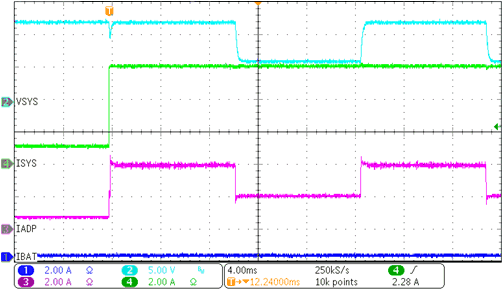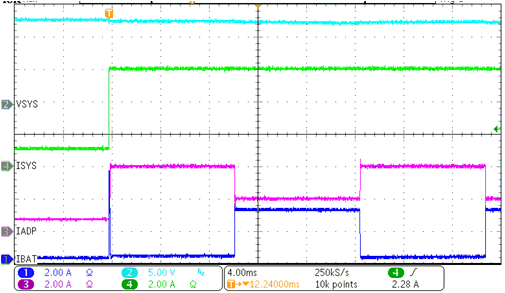SLUSFK8 April 2024 BQ25770G
PRODUCTION DATA
- 1
- 1 Features
- 2 Applications
- 3 Description
- 4 Device Comparison Table
- 5 Pin Configuration and Functions
- 6 Specifications
-
7 Detailed Description
- 7.1 Overview
- 7.2 Functional Block Diagram
- 7.3
Feature Description
- 7.3.1 Power-Up Sequence
- 7.3.2 MODE Pin Detection
- 7.3.3 REGN Regulator (REGN LDO)
- 7.3.4 Independent Comparator Function
- 7.3.5 Battery Charging Management
- 7.3.6 Temperature Regulation (TREG)
- 7.3.7 Vmin Active Protection (VAP) When Battery Only Mode
- 7.3.8 Two Level Battery Discharge Current Limit
- 7.3.9 Fast Role Swap Feature
- 7.3.10 CHRG_OK Indicator
- 7.3.11 Input and Charge Current Sensing
- 7.3.12 Input Current and Voltage Limit Setup
- 7.3.13 Battery Cell Configuration
- 7.3.14 Device HIZ State
- 7.3.15 USB On-The-Go (OTG)
- 7.3.16 Quasi Dual Phase Converter Operation
- 7.3.17 Continuous Conduction Mode (CCM)
- 7.3.18 Pulse Frequency Modulation (PFM)
- 7.3.19 Switching Frequency and Dithering Feature
- 7.3.20 Current and Power Monitor
- 7.3.21 Input Source Dynamic Power Management
- 7.3.22 Integrated 16-Bit ADC for Monitoring
- 7.3.23 Input Current Optimizer (ICO)
- 7.3.24 Two-Level Adapter Current Limit (Peak Power Mode)
- 7.3.25 Processor Hot Indication
- 7.3.26
Device Protection
- 7.3.26.1 Watchdog Timer (WD)
- 7.3.26.2 Input Overvoltage Protection (ACOV)
- 7.3.26.3 Input Overcurrent Protection (ACOC)
- 7.3.26.4 System Overvoltage Protection (SYSOVP)
- 7.3.26.5 Battery Overvoltage Protection (BATOVP)
- 7.3.26.6 Battery Charge Overcurrent Protection (BATCOC)
- 7.3.26.7 Battery Discharge Overcurrent Protection (BATDOC)
- 7.3.26.8 BATFET Charge Current Clamp Protection under LDO Regulation Mode
- 7.3.26.9 Sleep Comparator Protection Between VBUS and ACP_A (SC_VBUSACP)
- 7.3.26.10 High Duty Buck Exit Comparator Protection (HDBCP)
- 7.3.26.11 REGN Power Good Protection (REGN_PG)
- 7.3.26.12 System Under Voltage Lockout (VSYS_UVP) and Hiccup Mode
- 7.3.26.13 OTG Mode Over Voltage Protection (OTG_OVP)
- 7.3.26.14 OTG Mode Under Voltage Protection (OTG_UVP)
- 7.3.26.15 Thermal Shutdown (TSHUT)
- 7.4 Device Functional Modes
- 7.5 Programming
- 7.6 BQ25770G Registers
- 8 Application and Implementation
- 9 Power Supply Recommendations
- 10Layout
- 11Device and Documentation Support
- 12Revision History
- 13Mechanical, Packaging, and Orderable Information
Package Options
Refer to the PDF data sheet for device specific package drawings
Mechanical Data (Package|Pins)
- REE|36
Thermal pad, mechanical data (Package|Pins)
Orderable Information
8.2.3 Application Curves

| VBUS = 28 V | VSYS_MIN=12.3V | ISYS=0A |

| VBUS = 28V->0V | VBAT=14.8V |
| VSYS_MIN=12.3V | ISYS=100mA |

| VBUS = 28V | VBAT=14.8V |
| VSYS_MIN=12.3V | ISYS=100mA |

| VBUS = 5V | VBAT=14.8V |
| VSYS_MIN=12.3V | ISYS=1A |

| VBUS = 28V | VBAT=14.8V | ISYS=0~6A |

| VBUS = 5V | VBAT=14.8V | ISYS=0~0.5A |

| VBUS = 15V | VBAT=14.8V | IINDPM=5A | ISYS=0~8A |

| VOTG= 5V | VBAT=14.8V | IOTG=3A | IBUS=1A |

| VOTG= 5V | VBAT=14.8V | IOTG=5A | IBUS=0.3~2.7A |

| VBUS= 36V | ISYS=2~12A |
| SINGLE_DUAL_TRANS_TH=6A | PH_DROP_DEG=1ms |

| VBUS = 28 V | IIN_DPM=2A | ILIM2_VTH=200% |
| TMAX=20ms | TOVLD=10ms | ISYS=1~6A |

| VBUS = 5 V | VSYS_MIN=12.3V | ISYS=0A |

| VBUS = 10V->20V | VBAT=14.8V |
| VSYS_MIN=12.3V | ISYS=3A |

| VBUS = 28V | VBAT=14.8V |
| VSYS_MIN=12.3V | ISYS=2A |

| VBUS = 15V | VBAT=14.8V |
| VSYS_MIN=12.3V | ISYS=3A |

| VBUS = 15V | VBAT=14.8V | ISYS=0~4A |

| VBUS = 28V | VBAT=14.8V | IINDPM=5A | ISYS=0~10A |

| VBUS = 5V | VBAT=14.8V | IINDPM=3A | ISYS=0~2A |

| VOTG= 5V | VBAT=14.8V | IOTG=3A | IBUS=1A |

| VBUS= 36V | VBAT=14.8V | ISYS=12.2A |

| VBUS= 28V | ISYS=2~8A |
| SINGLE_DUAL_TRANS_TH=5A | PH_DROP_DEG=1ms |

| VBUS = 28 V | IIN_DPM=2A | ILIM2_VTH=200% |
| TMAX=20ms | TOVLD=10ms | ISYS=1~6A |